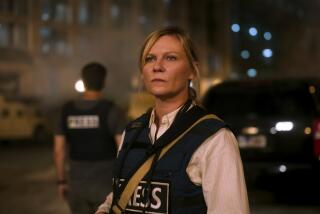Zombie virus re-infects screens
In a bucolic, Beatrix Potter cottage turned fortified makeshift bunker, Don (Robert Carlyle) and Alice (Catherine McCormack) are just sitting down to a pasta dinner with four other survivors of the viral outbreak that ravaged England in Danny Boyle’s “28 Days Later” when their party is crashed by a raging zombie horde. You wonder: Wasn’t this mess already cleared up?
In fact, it was -- briefly, anyway. The opening scene to Spanish director Juan Carlos Fresnadillo’s “28 Weeks Later” retraces its steps to the heart of the crisis (it never hurts to brush up on your history) before leading us from there through the American-led reconstruction effort about seven months later -- an effort, as you can probably guess, that doesn’t exactly go according to plan.
Laden with references to ongoing large-scale fiascos, “28 Weeks Later” is not an account of a disaster so much as it is the grisly anatomy of a quagmire. As the first film took us through the tail-end of the apocalypse through the eyes of someone who missed much of the action, the current film distributes its point of view among several characters who have witnessed too much. If “28 Weeks Later” lacks clarity and momentum, it may be at least partly because the situation it so pointedly reflects lacks it as well. One thing is for sure, Fresnadillo’s movie is grimmer and grislier than Boyle’s, and it wantonly abandons all hope.
Twenty-eight weeks after Don and Alice’s ill-fated dinner, American-led NATO forces have arrived to occupy Britain and declare it free of infection, and Don is safely ensconced in the Green Zone, where he’s been put in charge of securing the facilities at reconstruction headquarters. Alice, meanwhile, has been left for dead -- a seminal fact that Don chooses not to share with his kids, who were spared the horror thanks to a fortuitously timed school trip abroad.
Sixteen-year-old Tammy (Imogen Poots) and 12-year-old Andy (Mackintosh Muggleton), now officially the youngest people in Britain, return to find “a dramatically increased military presence,” as a cheerful American soldier puts it, where they’ll be pleased to find all the familiar amenities of home. That the soldiers like to pass the time spying on the newly arrived civilians through their rifle sights doesn’t bode well for the civilians’ future.
In deserted London, the new arrivals pass on their way to the Green Zone military personnel who are still hosing down doomed pleas for help scrawled across rooftops. As the military command drives to repopulate and reconstruct, the lone objection is raised by a military doctor named Scarlet (Rose Byrne), who worries that safety is being sacrificed in the rush.
Guilt and betrayal lurk darkly beneath the self-satisfied optimism of the new order. This time it’s the accidental discovery of a particular betrayal -- outside the well-controlled Green Zone -- that kicks off another outbreak, which doesn’t spread so much as it explodes within the locked-down area, unleashing an Armageddon of unrelenting, close-range violence. What happens when it becomes too hard to tell the infected from the innocent bystanders should come as no surprise. Once trust and judgment are called into question, protection and self-preservation quickly give way to preemptive aggression. As the mayhem in the streets spreads, the military imperative takes an ominous turn, and the good guys reveal themselves by their willingness to disobey orders.
As unmistakable as the allusions to contemporary large-scale fiascoes may be, the director’s message is less overtly political than it is allegorical -- that chaos breeds chaos and that force only serves to amplify it. Fresnadillo and his cinematographer Enrique Chediak amp up the claustrophobia by shooting the mayhem from a trapped rat’s-eye view, burrowing in tunnels with long lenses that scatter and dart in panic. In one of the movie’s most viscerally frightening scenes, Scarlet, Tammy and Andy descend into a dark tunnel where Scarlet leads them with her rifle’s night sight but the children must follow her blindly.
As a variation on a rich theme, the viral-zombie meme is an eminently mutable host-carrier. But Fresnadillo and writing partners Rowan Joffe, E.L. Lavigne and Jesus Olmo get slightly bogged down in possibilities. The perversion of peacekeeping is reflected in family betrayal -- Don becomes the zombie who won’t stay away, a stalker of his children -- but the stories don’t mesh quite as well as they might have, instead tending to dilute the metaphorical effect.
Fresnadillo has said in interviews that he was inspired by Aristotle’s conception of rage as suffering that’s given back, but this promising theme, though it’s suggested, isn’t fully realized here. “28 Weeks Later” lacks the streamlined thrust of its predecessor but makes for compelling, adrenaline-fueled viewing just the same. Is Don a latter-day Cronos, preserving his power by attempting to devour his young, or a cowardly collaborator incapable of looking out for anyone but himself? Either way, one thing seems clear: Once you turn on your own to protect yourself, there’s no turning back. You really can’t go home again.
“28 Days Later.” MPAA rating: R for strong violence and gore, language and some sexuality and nudity. Running time: 1 hour, 31 minutes. In general release.
More to Read
Only good movies
Get the Indie Focus newsletter, Mark Olsen's weekly guide to the world of cinema.
You may occasionally receive promotional content from the Los Angeles Times.









